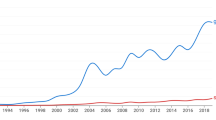Abstract
Using the Public Value Mapping framework, I address the values successes and failures of chemistry as compared to the emerging field of green chemistry, in which the promoters attempt to incorporate new and expanded values, such as health, safety, and environmental sustainability, to the processes of prioritizing and conducting chemistry research. I document how such values are becoming increasingly “public.” Moreover, analysis of the relations among the multiple values associated with green chemistry displays a greater internal coherence and logic than for conventional chemistry. Although traditional chemistry research has successfully contributed to both economic and values gains, there have been public values failures due to imperfect values articulations, failure to take a longer-term view, and inertia within a system that places too much emphasis on “science values.” Green chemistry, if implemented effectively, has potential to remedy these failures.

Similar content being viewed by others
Notes
http://www.un.org/esa/dsd/dsd/dsd_index.shtml (last accessed 9/10).
http://www.epa.gov/sustainability/ (last accessed 9/10).
http://sites.nationalacademies.org/PGA/sustainability/index.htm (last accessed 9/10).
Intrinsic values represent valued outcomes that are the ends of an endeavor, whereas instrumental values represent the means to reaching an intrinsic value goal. Bozeman (2007) provides the example of vaccination as an instrumental value that can enhance the intrinsic value of public health.
http://www.rpi.edu/~woodhe/docs/green.html#N_1_ last accessed 7/09.
http://www.warnerbabcock.com/index.html last accessed 4/09.
http://greenchemistry.yale.edu/about_the_center/ last accessed 4/09.
http://greenchemistry.yale.edu/definitions/ last accessed 4/09.
http://blogs.sciencemag.org/scienceinsider/2009/05/green-chemist-n.html last accessed 5/09.
References
American Chemistry Council, (ACS). 2007. Snapshot of the Chemical Industry in the United States. Washington, D.C.: American Chemistry Council.
AAAS. 2008. Analysis of R&D in the FY 2009 Budget. American Association for the Advancement of Science, Washington, D.C. http://www.aaas.org/spp/rd/fy09.htm. Accessed Sept 2009.
Anastas, Paul. 2003. Meeting the challenges to sustainability through green chemistry: Paul T. Anastas of the Chemistry Department, University of Nottingham in the UK discusses green chemistry as an approach toward meeting the goals of sustainability. Green Chemistry 5: G29–G34.
Anastas, Paul, and John Warner. 1998. Green Chemistry: Theory and Practice. New York: Oxford University Press.
Baum, R. 2010. A Shout-Out for Green Chemistry. Chemical and Engineering News 88(13): 8.
Bozeman, Barry. 2002. Public Value Failure and Market Failure. Public Administration Review 62(2): 145–161.
Bozeman, Barry. 2003. Public Value Mapping of Science Outcomes: Theory and Method. Pages 3-49 in Knowledge Flows and Knowledge Collectives: Understanding the Role of Science & Technology Policies in Development: Volume 2. ed. D. Sarewitz. http://citeseerx.ist.psu.edu/viewdoc/download?doi=10.1.1.105.6459&rep=rep1&type=pdf. Accessed Nov 2010.
Bozeman, Barry. 2007. Public Values and Public Interest: Counterbalancing Economic Individualism. Washington, D.C.: Georgetown University Press. 214 pp.
Bozeman, Barry, and Daniel Sarewitz. 2005. Public values and public failure in U.S. science policy. Science and Public Policy 32: 119–136.
Bush, Vannevar. 1945. Science: The Endless Frontier. U.S. Government Printing Office, Washington, D.C. NSF http://www.nsf.gov/od/lpa/nsf50/vbush1945.htm. Accessed Nov 2010.
Green Chemistry Institute (GCI). 2009. ACS GCI Pharmaceutical Roundtable: 2008 Year in Review. Washington, D.C.: Green Chemistry Institute.
Kidwai, Mazaahir. 2001. Green chemistry in India. Pure Applied Chemistry 73: 1261–1263.
Matus, Kira J. M., Paul T. Anastas, William C. Clark, and Kai Itameri-Kinter. 2007. Overcoming the Challenges to the Implementation of Green Chemistry. Center for International Development at Harvard University.
National Environmental Technology Institute (NETI). 1998. The Role of Polymer Research in Green Chemistry and Engineering: Workshop Report. National Environmental Technology for Waste Prevention Institute/Center for UMass/Industry Research on Polymers, Amherst.
Nugent, Nicola. 2007. Interview: the rise and rise of green chemistry in China. Chemical Science, January 12: pg. 3.
Ouellette, Robert J. 1997. Introduction to General, Organic, and Biological Chemistry, Fourth edition. Prentice Hall, Upper Saddle River, NJ.
Pauling, Linus, and Peter Pauling. 1975. Chemistry, W.H. Freeman and Company, San Francisco.
Pauling, Linus. 1958. General Chemistry, 2nd edition. W. H. Freeman and Company, San Francisco.
Royner, Sophie L. 2009. Academic R&D Spending Trends. Chemical & Engineering News 87: 26–30.
Steinfeld, Jeffrey L. 2002. Sustainability and the Chemical Enterprise. Chemical & Engineering News 80(50): 51.
Thurgood, Lori, Mary J. Golladay, and Susan T. Hill. 2006. U.S. Doctorates in the 20th Century. NSF Division of Science Resources Statistics, Washington, D.C.
Tickner, Joel. 2009. Semi-structured interview with Dr. Joel Tickner, Lowell Center for Sustainable Production and Green Chemistry and Commerce Council, on 03/02/09.
Trost, Barry M. 1991. The atom economy—a search for synthetic efficiency. Science 254: 1471–1477.
Vitousek, Peter M., Harold A. Mooney, Jane Lubchenco, and Jerry M. Melillo. 1997. Human Domination of Earth’s Ecosystems. Science 277: 494–499.
Warner, John C. 2008. Semi-structured interview with J. Warner, Director, Warner-Babcock Institute for Green Chemistry.
Weinberg, Alvin W. 1971. The Axiology of Science. American Scientist 58: 612–617.
Woodhouse, Edward J. 2003. Change of State? The Greening of Chemistry. In Synthetic Planet—Chemical politics and the hazards of modern life, ed. M.J. Casper, 177–193. New York: Routledge.
Woodhouse, Edward J., and Steven Breyman. 2005. Green Chemistry as Social Movement. Science, Technology, and Human Values 30: 199.
Zumdahl, Steven S., and Susan A. Zumdahl. 2006. Chemistry, 6th edition.
Acknowledgments
Daniel Sarewitz and Barry Bozeman provided valuable guidance and project support, and Dan also contributed ample editorial help. Additionally, the rest of the PVM project group, including Genevieve Maricle, Ryan Meyer, Catherine Slade, and Walter Valdivia, provided early feedback and help with project scoping. This research was funded by a generous grant from the V. Kann Rasmussen Foundation.
Author information
Authors and Affiliations
Corresponding author
Rights and permissions
About this article
Cite this article
Logar, N. Chemistry, Green Chemistry, and the Instrumental Valuation of Sustainability. Minerva 49, 113–136 (2011). https://doi.org/10.1007/s11024-011-9165-3
Published:
Issue Date:
DOI: https://doi.org/10.1007/s11024-011-9165-3



